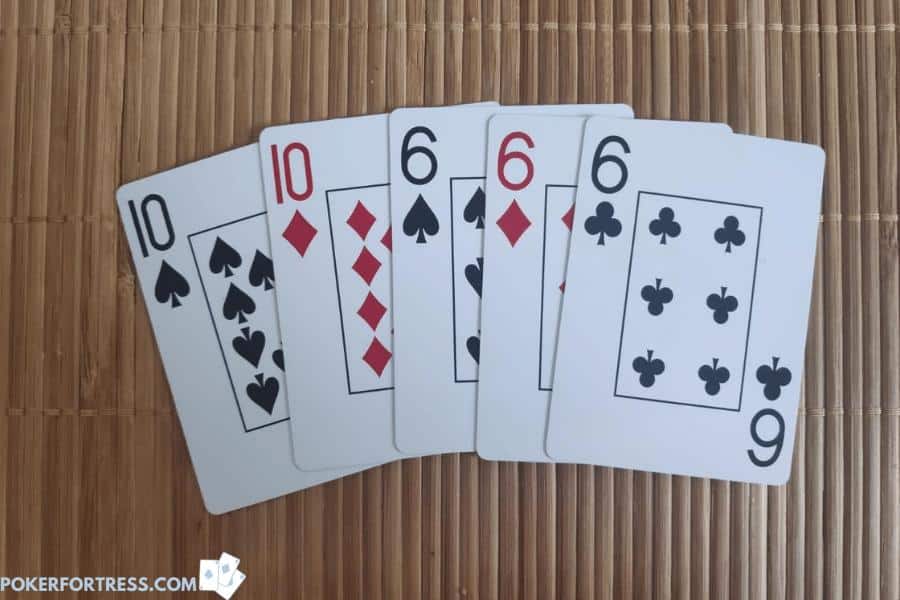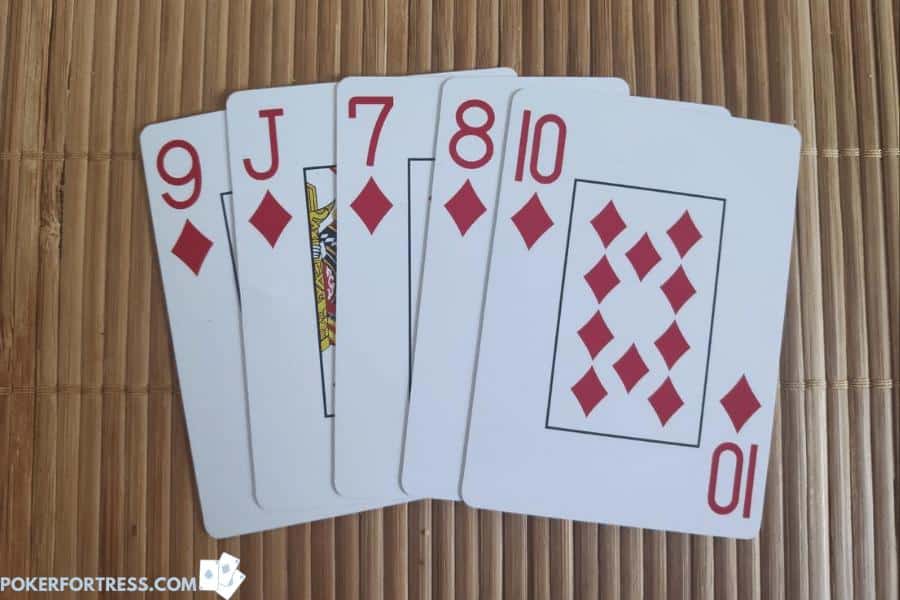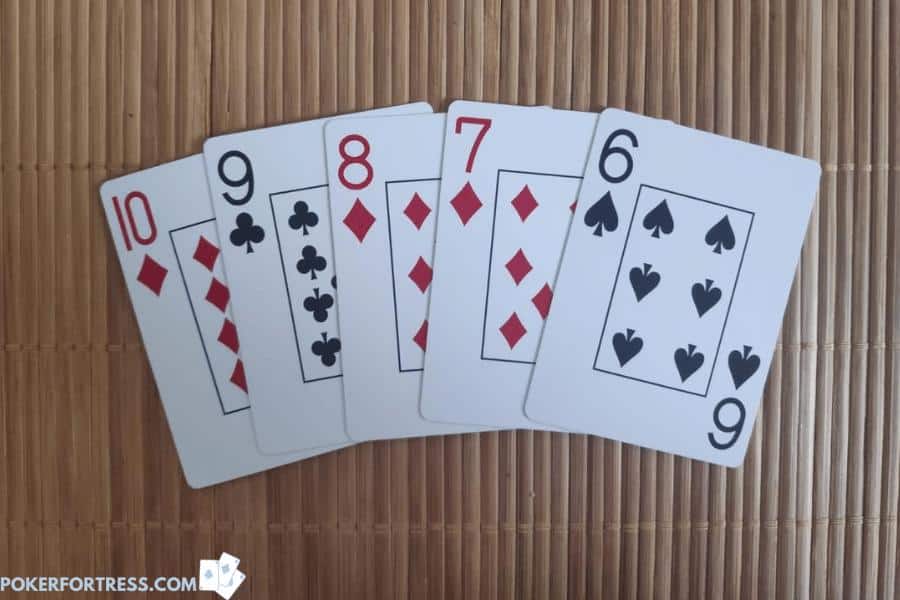5 Card Draw is one of the most popular variations of poker. It’s also the easiest to understand, making it the perfect game for a night with friends. However, its simplicity has led to one of the most challenging situations for anyone playing this game—pat hand.
In draw poker, pat hand refers to a 5-card hand—straight, flush, full house, four-of-a-kind, or straight flush—that you can’t improve. It’s possibly the best hand in the game or has a very high chance of winning. However, it can be tough to extract value from it because you can’t draw new cards.
Pat hand is easy to understand but challenging to play. We’ll discuss everything about it to help you understand why it can be dangerous to have a pat hand when playing 5 Card Draw. We’re also going to share one easy strategy that can help you extract value from a pat hand.

Pat Hand: A Double-Edged Sword
To help you understand why a pat hand can be a double-edged sword, let’s quickly go through the rules of playing 5 Card Draw:
- To start the game, each player should agree to an amount as their initial bet, then place it at the center of the table.
- Players will receive five cards each, face down, and get a chance to inspect their cards.
- Players can discard the cards they don’t need to try and improve their hands. Note: Each player can only discard a maximum of three cards.
- For the second round, players can fold or choose to stay in the game. The ante is twice the amount of the initial bet they placed.
- Showdown starts, and the player with the best hand wins the pot.
5 Card Draw is so simple that even with such a brief explanation, you’ll know how to play it.
However, this game includes 5-card hands in the rankings, and each player gets five cards at the start of the game. So, there’s a possibility that a player picks up any of these made hands:
- Straight (5♠ 6♦ 7♥ 8♠ 9♣)
- Flush (3♥ 5♥ 8♥ T♥ K♥)
- Full House (8♣ 8♦ 8♥ K♦ K♥)
- Four-of-a-Kind (5♣ 5♦ 5♥ 5♠ J♠)
- Straight Flush (8♣ 9♣ T♣ J♣ Q♣)
If you happen to draw any of these hands, you have a pat hand. What this means is that you can’t discard anything to improve your current hand. It’s a dominant hand because there are only two betting rounds in a 5 Card Draw, and players only have one chance to improve their ranking. So, if you have a pat hand, it’s likely that you’ll win the game.

When playing 5 Card Draw, the only data that you can get from your opponent is the number of cards that they discard.
You can’t see any of your opponents’ cards, and there are no community cards that you can use as a basis for your decisions. So, every move that you’ll make will depend on the number of cards that your opponents discard—the more cards they draw, the weaker their hands are.
If you have a weak hand, say a low-value pair, and your opponent only discards one card, it’s most likely that they have a strong hand, maybe even a four-of-a-kind! The data that you’re getting in a 5 Card Draw is only from one source, but it’s accurate in figuring out how your hand stacks up against the other players.
It’s where things get hard for players with a pat hand. If you want to improve your hand, you’ll need to discard some of your cards to draw new ones. There’s only one more betting round after that, and whatever you discard will be the basis of your opponents on whether they call or fold.
If you want to extract value from one round, you have to keep everyone in the game. The only way to do that is to make them think that your hand is weaker than what they have. Unfortunately, you only have one discarding round, leaving you with only three options:
- If you discard anything, you break a strong hand. If you have a four-of-a-kind, you can discard one, and it’ll still be the strongest in the game. But if you break a straight, flush, or straight flush, you have air unless you get lucky with your draw.
- If you split a full house, others might beat you. Let’s say you have 4♣ 4♦ 4♥ K♦ K♥, and you decide to discard K♦ K♥. Three-of-a-kind is still a relatively strong hand, but it increases the chances that someone beats your hand.
- If you don’t discard anything, everyone folds. If you have a straight, flush, or straight flush, it’s the only path that you can take, but the most logical step for your opponents is to fold.
When you’re playing 5 Card Draw, you want to have the best hand while creating an impression that you have a weak hand. That’s the only way for you to extract value in every game. So, the question is: is a pat hand strong or weak?

The answer depends on how well you’ve played other hands and make yourself unpredictable.
Easiest Strategy to Extract Value From a Pat Hand
You might be wondering how you can make yourself unpredictable in a game that is so simple as 5 Card Draw, right? After all, it plays nothing like the more sophisticated 5 Card Stud, which many people still think is the same thing and can’t tell what’s the difference between the two.
There’s a thin line in this strategy that allows a player to take advantage of bluffing, but not in a way that you might expect. In other poker variations, you want to have the right mix of bluffing and value betting to keep your opponents guessing.
In a 5 Card Draw, you want to keep bluffing until they catch you.
If you have a pair or anything remotely playable, don’t discard anything. Most of the time, the other players will fold, especially when you do it for the first couple of times. It’s a source of steady profit, but the other players won’t let it pass. The more you bluff, the more likely you get caught, and that is what you want to happen.
You want your opponents to believe that bluffing is possible with 5 Card Draw, and you’re doing it to steal their initial bets. As soon as you get caught, stop bluffing. The next time you don’t discard anything is when you have a pat hand. Since you already created an impression that if you’re not discarding anything, you have a weak hand and you’re only trying to steal their bets, more players will join the second betting round.
The key to pulling off this strategy is to get caught bluffing, then stop, then make sure you get caught again. You want to do it continuously until you establish enough unpredictability. The more it happens, the harder it’ll be for your opponents to read through you, and the easier it’ll be for you to extract value from a pat hand.
Conclusion
Pat hand is, possibly, the best hand in the game, but you can only extract value from it if you play correctly. Poker has many variations, with different gameplay, but the one thing similar in all of them is that they’re always for the long game. I’m not aware of any poker variation that starts and ends in one round. It’ll always be a long game, and you can use each round to build an unfair advantage.
If you get caught bluffing in a 5 Card Draw, you may have lost that round, but you’ve already won the game. That’s because you’ve made yourself unpredictable for your opponents, making it easier to extract value from a pat hand or steal bets using your weak hands.



